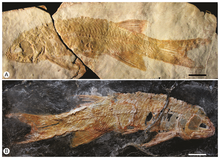Holostei
| Holostei Temporal range:
| |
|---|---|

| |
| Spotted gar, Lepisosteus oculatus | |

| |
| Bowfin, Amia calva | |
| Scientific classification | |
| Kingdom: | |
| Phylum: | |
| Class: | |
| Subclass: | |
| Infraclass: | Holostei
|
| Orders | |
Holostei are bony fish that retain basal characteristics inherited from an early time in their evolution. There are eight species divided among two orders, the Amiiformes represented by a single living species, the Bowfin (Amia calva), and the Lepisosteiformes, represented by seven living species in two genera, the gars. Further species are to be found in the fossil record and the group is often regarded as paraphyletic. Holosteians are closer to teleosts than are the chondrosteans, the other group intermediate between teleosts and cartilaginous fish. The spiracles are reduced to vestigial remnants and the bones are lightly ossified. The thick ganoid scales of the gars are more primitive than those of the bowfin.
Characteristics
Holostei share with other non-teleost ray-finned fish a mixture of characteristics of teleosts and sharks. In comparison with the other group of non-teleost ray-finned fish, the chondrosteans, the Holostei are closer to the teleosts and further from sharks: the pair of spiracles found in sharks and chondrosteans is reduced in holosteans to a remnant structure: in gars, the spiracles do not even open to the outside;[1] the skeleton is lightly ossified: a thin layer of bone covers a mostly cartilaginous skeleton in the bowfins. In gars, the tail is still heterocercal but less so than in the chondrosteans. Bowfins have many-rayed dorsal fins and can breathe air like the bichirs.
The gars have thick ganoid scales typical of sturgeons whereas the bowfin has thin bony scales like the teleosts. The gars are therefore in this regard considered more primitive than the bowfin.[2]
The name Holostei derives from the Greek, holos meaning whole and osteon meaning bone: a reference to their bony skeletons.
Phylogeny

The cladogram shows the relationship of the Holostei to other bony fish, the great majority of which are Teleosts,[4] and to the terrestrial vertebrates (tetrapods) that evolved from a related group of fish.[5][6] Approximate dates are from Near et al, 2012.[4]
| Osteichthyes |
| |||||||||||||||||||||||||||||||||
Notes
- ^ Thus the former "Chondrostei" is not a clade, but is broken up.
References
- ^ Ontario. Game and fish commission
- ^ Rick Leah. "Holostei". University of Liverpool (http://www.liv.ac.uk).
{{cite web}}: External link in|publisher= - ^ Brito, Paulo M.; Alvarado-Ortega, Jesus. PLoS ONE. 8 (9): e73551 http://www.plosone.org/article/info%3Adoi%2F10.1371%2Fjournal.pone.0073551.
{{cite journal}}: Missing or empty|title=(help)CS1 maint: multiple names: authors list (link) - ^ a b Thomas J. Near; et al. (2012). "Resolution of ray-finned fish phylogeny and timing of diversification". PNAS. pp. 13698–13703. doi:10.1073/pnas.1206625109.
{{cite web}}: Explicit use of et al. in:|author=(help) - ^ Betancur-R, Ricardo; et al. (2013). "The Tree of Life and a New Classification of Bony Fishes". PLOS Currents Tree of Life (Edition 1). doi:10.1371/currents.tol.53ba26640df0ccaee75bb165c8c26288.
{{cite journal}}: CS1 maint: unflagged free DOI (link) - ^ Laurin, M.; Reisz, R.R. (1995). "A reevaluation of early amniote phylogeny". Zoological Journal of the Linnean Society. 113: 165–223.
{{cite journal}}: CS1 maint: multiple names: authors list (link)

